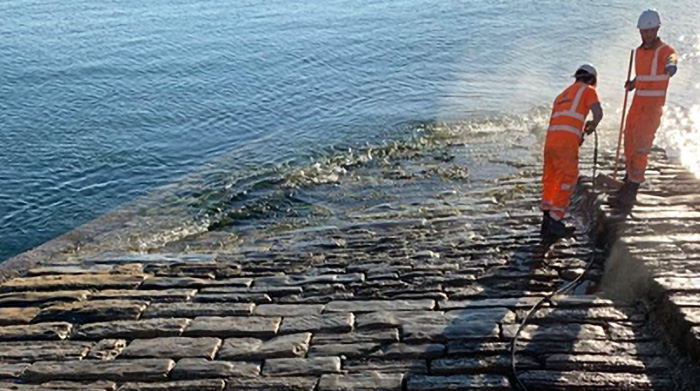
Swanage Stone Quay Repairs
The Stone Quay is sited in the popular seaside town of Swanage. Hugely popular for tourism and water sports. The Stone Quay and the attached sea retaining wall were originally built in the early 19th century by William Morton Pitt composed of large blocks of Purbeck Stone. The quay was intended for the stone export and fishing industries, the remains of the stone tramway that was used to transport the stone to the waiting ships can still be seen.
Through ingress from wave action, over a long period of time, this rubble had gradually been washed out to leave a void filled with water on high tides. Initially bridging the void entirely, an area of the stone encasement eventually collapsed into the void below, leaving the area very unsafe during a very busy holiday season in the town as the quay itself is a very popular location in the summer for crabbing and children playing and it was something that the locals were very keen to see fixed because of the danger it posed.
Initial thinking was to look for gaps in the leading edge to be filled, to allow for concrete to be poured in the void behind. We rejected this philosophy as the leading-edge area was particularly tidal, and with poor quality construction in this area we brought in the risk of concrete grout leaking on to the beach, creating pollution and leaving an uncertain quality of repair in the void. Instead, we used pumped sea water to clean the beach sand out that was partially filling the void. Filling with water on a low tide washed this material out through the gaps creating the initial problem. We then brought some specialist knowledge to the table in terms of our use of grout filled mattresses and bag work that we frequently use on scour protection schemes associated with rail structures. We thus deployed and filled two large grout mattress bags within the void. These were filled with pumpable P40micro concrete and pushed out into the recesses of the void, under hydrostatic pressure, as the filling continued.
Having filled the bulk of the void, sealing all external openings in the process, we could then top off with in-situ concrete. The recovered stones were too heavy to lay, in a difficult to access area for construction lifting plant. We cut stones down to form lighter “slippers”, that could then be safely laid by hand. We supplemented the stones with some new material sourced from our own Purbeck stone quarry in Swanage. The final solution proved very in keeping with the original construction, and the client was pleased with a safe and efficiently delivered project.



Good value, high quality materials and service